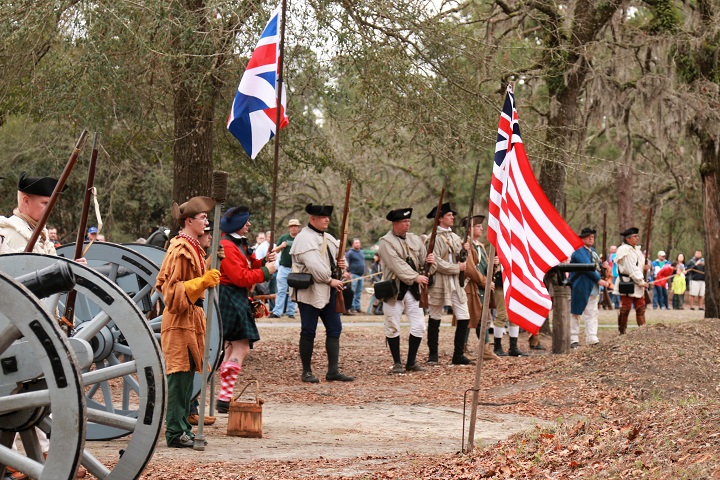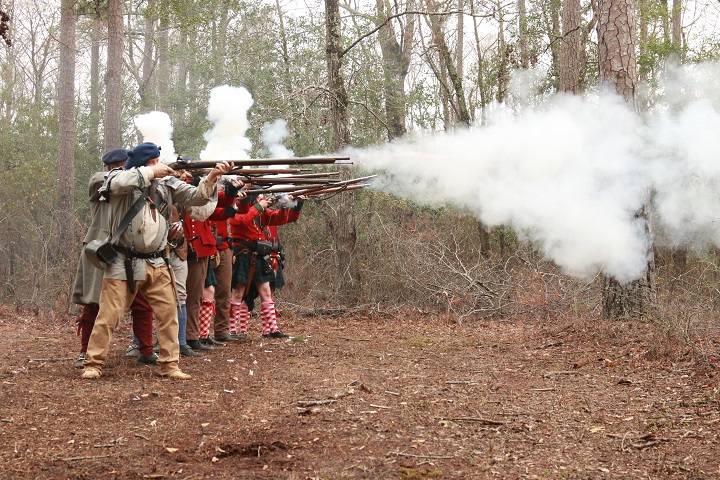
Loyalist forces, those still loyal to King George III, were trying to link up with British naval forces outside of Wilmington.
Moores Creek, in present-day Pender County, was the last barrier keeping them from that goal, Jason Collins, chief of interpretation for Moores Creek National Battlefield, told Coastal Review Online.
Supporter Spotlight
A battle ensued on Feb. 27, 1776, between the Patriot forces and Loyalist forces, each numbering about 1,000 men, for control of Moores Creek Bridge.
“The Loyalists believed that the Patriots had their backs to the creek and would be easy targets,” Collins explained.
Supporter Spotlight
“What the Loyalists didn’t realize was that the Patriots had left fires burning on one side of the bridge and had crossed over to the other side with more troops. As the Patriots crossed, they took up many of the planks of the bridge leaving just the support beams behind,” he said.
“They coated the bridge with tallow and soap, which made it treacherous to cross. After the Loyalists were able to cross the bridge, they were met by devastating fire from the Patriots.”
During the battle, which Collins said some accounts have as lasting around 3 minutes, the Loyalists lost somewhere between 30-40 soldiers, “there were probably many more casualties, as some of the Loyalists drowned in the creek.”
The site, now the Moores Creek National Battlefield and part of the National Park Service, will commemorate Feb. 22-23 the 244th anniversary of the Battle of Moores Creek Bridge, which changed the course of the war in this region.
“It was the first decisive Patriot victory of the American Revolution. The British had plans to link up with the Loyalist forces in North Carolina and invade Charleston, South Carolina. The victory at Moores Creek derailed those plans and after the British were defeated in Charleston, British attention shifted to the Mid-Atlantic states for three years,” Collins said.
In large part because of the Patriot victory at Moores Creek, North Carolina instructed its delegates to the Continental Congress to vote for independence, the Halifax Resolves, in April 1776, he explained. “It was the first colony to take such an important step towards independence. That is why North Carolina has ‘First in Freedom’ on its license plates.”
During the free, two-day event 10 a.m. to 4 p.m. both Feb. 22 and Feb. 23, visitors will be able to step back to the 18th century and tour battlefield encampments, watch historic weapons demonstrations, and visit with artisans.
“The park has been hosting this event annually for several years. The first documented anniversary commemoration goes all the way back to 1856 for the 80th anniversary. It wasn’t always consistently celebrated after that, but that’s the first date we can document,” Collins explained.

As part of the commemoration, there will be Loyalist and Patriot programs throughout the weekend.
“The Loyalist program will highlight the around 1,000 Loyalists who fought at Moores Creek. They will talk about where the Loyalists came from and what kind of weapons that they use. The program also includes a musket demonstration,” said Collins. “The Patriot program is actually a description of the battle using muskets and cannons. We will have a narrator sharing about what went on during the battle and as he speaks, the cannons fire and the muskets fire. It gives visitors a pretty good idea what the Battle of Moores Creek was like.”
Suzanne Adair of Raleigh will present a program on, “The Crucial Role of North Carolina during the American Revolution” at 2 p.m. in the Visitor Center and will hold a book signing both before and after her program. Adair is the author of an award-winning mystery series set during the American Revolution in North Carolina.
During the presentation, Adair will put into perspective Revolutionary War-related events in North Carolina from 1771 through 1781, including the Battle at Moores Creek Bridge in 1776.
“Historians often miss the importance of the Old North State in the American War of Independence. Until Lord Cornwallis surrendered at Yorktown, however, 1781 had looked like a frustrating, stalemate year for the patriot cause — largely due to the Continental Army’s huge thorn-in-the-side lodged in coastal North Carolina,” according to a description of the presentation provided by Adair. She will discuss the British Army’s “audacious, confident gambit for North Carolina that tied the hands of Continental commanders during most of 1781, nearly costing patriots their victory.”
As for how coastal North Carolina was affected, she said that in the lead up to the 1776 battle, the Scots were trying to rendezvous with other loyalists who were on the coast, and it was the main goal of the Patriots to stop the two groups of loyalists from uniting against them.
In Adair’s mystery series that takes place five years after the battle at Moores Creek Bridge, Crown forces from the 82nd Regiment of Foot occupied Wilmington in January 1781. The was goal to assist Lord Cornwallis in subduing resistance in the North Carolina interior.
“The 82nd controlled southeast and coastal North Carolina for almost that entire year, supporting the state’s loyalists in a terrible civil war and stymieing the Continental Army’s use of North Carolina during that time. This piece of history isn’t taught in most public schools, but it shows an important lesson about how quickly and thoroughly the British exploited multiple weaknesses in Continental strategy,” Adair wrote in an email to Coastal Review Online.
The commemoration begins at 10 a.m. Feb. 22 with a wreath laying ceremony hosted by the Moores Creek Battleground Association, the park’s friends, or fundraising group. Collins said that members of the Daughters of the American Revolution, Sons of the American Revolution, Scottish Society of Wilmington and Children of the American Revolution from a variety of places bring wreaths to be placed at four of the monuments in the park.
The procession begins at the visitor center and will visit each of the monuments, where a wreath will be placed. Most of the wreathes are placed at the Grady Monument/Patriots Monument. John Grady from Duplin County was the only Patriot death during the battle.
Once the procession arrives at the Grady Monument, a ceremony is held with a guest speaker who honors the Patriots and Loyalists who fought at Moores Creek. The different groups are recognized as they salute the Grady monument.
John Golden will perform on the guitar and sing folk music at 12:30 p.m. and 3 p.m. Feb. 22. “He puts stories of North Carolina history to music, which makes him popular with folks in the Cape Fear region,” Collins added.
All demonstrations including the glass blower and candle maker will be ongoing, but the musket and cannon demonstrations will be at scheduled times.
“Our candle maker and quill and ink writing stations will be hands-on. The glass maker and period cooking will be our volunteers showing visitors the process of blowing glass and cooking in an 18th century kitchen, but they won’t necessarily be hands-on.”
All of the toys and games are hands-on activities and volunteers will invite the kids to play along, he said. Throughout the day, there will be toys and games similar to what children in the 18th century played including Jacob’s ladders, cup and ball, card games and varieties.
Collins said the schedule of events will be posted on the park’s website and Facebook page as soon as its finalized and programs will be distributed during the event. Event information will be posted on both sites as it becomes available.







